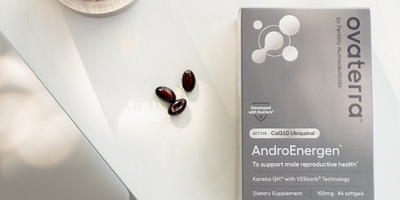Are you looking for a way to know if your body is ready to conceive? Everything has to be “just right” with your body’s cycle to create a baby. An ovulation test or LH test can help you know when you are about to ovulate, so you can time your intercourse and improve your chances of pregnancy.
Women are fertile only 4-5 days each cycle, which means that timing is everything when it comes to getting pregnant. So, let’s dive into when you should take an ovulation test in your cycle.
What are ovulation test strips and how do they work?
Ovulation strips are used to detect when you are most fertile - or most likely to become pregnant in each cycle. Many women use these strips to help increase their chances of getting pregnant. Although you can typically take an ovulation test any time of day, many ovulation strips prefer that you use your morning urine. (More on this later.)
Ovulation testing strips can be a key tool for you during your motherhood journey. There are several types of ovulation testing kits.
Ovulation tests using LH
Many ovulation test strips work by testing your luteinizing hormone levels (LH), which can be detected in your urine. The rise in luteinizing hormone is responsible for stimulating your ovaries to release the egg (i.e., ovulation), a crucial process for reproduction.
The LH level in your urine increases when you are on the most fertile days of your cycle. This soar in LH levels happens one to two days before you ovulate. That’s why your ovulation test results can give you a good idea of when your body is ready to conceive.
Ovulation tests using PdG
Ovulation predictor kits can also tell you when ovulation has already occurred. This is done by detecting another hormone, the Pregnanediol-3a-glucuronide (PdG) hormone in your urine. PdG is a metabolite of progesterone, a hormone released by the ovaries after ovulation to prepare the uterus for implantation.
An increase in PdG indicates that your body has recently released an egg to be fertilized. You’ll see a test line that typically looks darker than the control line, so you know you’re ready to ovulate.
Combination ovulation tests
Some ovulation tests use both LH and PdG, or other hormones like estrogen to better detect ovulation.
How to use ovulation test strips to predict your most fertile days
The ovulation testing strips must be used at a specific time in your cycle. To understand how you’d best use ovulation testing strips, first, let’s talk about how the menstrual cycle works.
For many women, a menstrual cycle lasts 28 to 32 days, although it can range anywhere from 21-40 days to be considered “normal.” Many women have longer or shorter cycles or have irregular cycles.
In fact, one in five women experiences irregular menstrual cycles. This can mean that periods are longer or shorter than what is considered “normal” or that the lengths of their cycles vary, cycle to cycle.
When your period starts, that is considered the first day of your menstrual cycle. Be sure to count day one when you have a full flow. For example, if you have light spotting one day but a full flow the next day, you wouldn’t count the day you “spotted” as day one. Instead, you would wait until you experience regular menstrual bleeding.
Knowing when your first day of the cycle occurs is essential for timing.
The next thing you need to estimate is when ovulation happens. While ovulation doesn’t happen at the same point in the cycle for everyone, there is a window in which we know ovulation is likely to occur. The rule of thumb for ovulation is 14 days before your next period, if your cycle length is 28 days. When you use an ovulation test, it will detect a luteinizing hormone surge one to two days before ovulation happens.
Example: If you have a 28-day cycle, and you started your period on July 1st (the first day of the cycle), an ovulation test stick would start detecting higher levels of LH on July 13th or 14th, and you would ovulate on the 15th (14 days before your next period).
Ovulation doesn’t always happen right in the middle of your cycle. To catch the LH surge, you may want to start testing for 17-18 days before your next period. Starting to test a few days before lets you avoid missing your fertile time.
Important Note: As we mentioned before, only a minority of women have a 28-day cycle. If you have a longer or shorter menstrual cycle, you would need to adjust your estimation. It is important to track your periods using an ovulation tracker or app, to understand your body’s natural cycle better. (The example above is meant to show you how to calculate 14 days before your period starts.)
Most ovulation testing kits come with plenty of testing strips (typically 10-15 strips), so you can test for your LH rise on many days until you get a positive result. There is an 80% chance of detecting ovulation with five days of testing and a 95% chance with ten days of testing.
What to do when you test positive
Once you see a positive result on your ovulation testing strips, you will want to have intercourse as soon as possible. Your fertile window lasts about 4-5 days. It’s because sperm can survive in the fallopian tube for approximately five days but an egg can survive for just 12-24 hours after ovulation.
So, after the egg is released from the ovary, sperm has 12 to 24 hours to fertilize the egg. Your best chance of getting pregnant is a few days before and about one day after ovulation has occurred. This is why it’s so important to track ovulation to pinpoint your fertile window.
How accurate are ovulation test strips?
Studies have suggested that ovulation testing strips are 95 percent effective at detecting the surge of LH in your urine.
However, ovulation tests can be less reliable if you:
- Have irregular periods with an unpredictable cycle length, which can make it tricky to estimate when to test
- Have health conditions like PCOS that affects LH levels
- Are over 40 or close to menopause, which means your LH levels can be elevated throughout the cycle
- Are taking medications that affect LH levels
Furthermore, simple ovulation tests can be confusing to interpret. Some newer ovulation trackers solve much of that problem (and more) by using smartphone apps and algorithms that interpret the results for you.
Any downsides or risks to using ovulation strips?
While urine tests like ovulation strips are easy to use and can have accurate results, they are not perfect and do have some downsides. Here are a few:
- You may experience high levels of LH more often than what is typical, especially if you have PCOS, are in menopause or are of advanced maternal age (40+).
- It is possible to misread a positive or negative result (think faint lines), and there is usually a learning curve involved, especially if your cycles are irregular.
- For women whose cycles are not 28 days, it can take a few cycles to figure out which days to use the ovulation test strips.
- If your menstrual cycle is irregular, it may be difficult to pinpoint when to test, which can be stressful. You can also end up incurring additional costs, having to test for many cycles.
Other than the risk of an inaccurate result, such as a false positive, testing strips are non-invasive and will not cause medical complications.
How much do ovulation test strips cost?
The cost of testing strips varies. It largely depends on the brand and what the test includes. For a high-quality at-home test that provides more than just a few strips for testing, you may pay between $100 and $200. These may be thought of more as ovulation trackers or fertility monitors than simple ovulation tests, as most come with an app that helps you figure out when to test, how to interpret the results and what to do based on the results.
An ovulation test done at a medical office may be more costly than an at-home test depending on your insurance plan. For a simple at-home test without a digital reader, multiple testing strips, and an included fertility app, you may pay between $12 and $25 per cycle. More sophisticated ovulation trackers and fertility monitors can be anywhere from around $40 per cycle to over $250 (as a one-time purchase price).
Are ovulation tests covered by insurance?
If you have a health spending account (HSA) or flexible spending account (FSA) with your health insurance, ovulation trackers and fertility monitors are usually eligible. Usually, all you need is a receipt, but ask the plan administrator how you can get reimbursed for ovulation tracking kit purchases.
Tips on how to get the most accurate reading:
Make Sure Your Urine Is Concentrated Enough
The usual recommendation is to use the testing strip in the morning. It’s because your urine is likely to be the most concentrated right after you wake up. The hormones may be easier to detect if you have just woken up without food or water consumption. This is quite similar to a pregnancy test recommendation.
Follow the Package Directions Carefully
Read every word. You don’t want to waste time and money because you used the tests incorrectly. It will only take a few minutes to read over the instructions to better your chances of an accurate test result.
Urine-based ovulation tests Ovaterra’s scientific team recommends
There are two tests that we recommend: Proov Predict & Confirm Kit and Oova Ovulation Tracking Kit.
- Tests two hormones, LH and PdG, to predict your 2- to 3-day fertility window and confirm ovulation
- Included Proov app makes it easy to know when to test, interprets your results and lets you know what to do based on the results
- Tracks your score for each cycle to understand and improve your chances of implantation
- Uses a patented method to assess the quality of your implantation window
- Budget-friendly on a per-cycle basis and easy to use
- Tests two hormones, LH and PdG, in one test strip
- Has the same level of precision as a lab test, but from the comfort of your home
- Predicts 3- to 5-day fertile window, based on your unique cycle pattern
- Works well for women who have irregular cycles
- Includes an intuitive app and a provider portal that your doctor can receive your results from, real-time
Both Proov and Oova belong to a group of ovulation tests we consider "next-generation." Next-gen ovulation trackers use algorithms to take the guesswork and inaccuracies out of your ovulation tracking. For example, many of the newer ovulation trackers tell you exactly when to take the ovulation test - no need to calculate the timing on your own. Here's our guide to choosing the ovulation tracker that best fits your needs.
Takeaway
Understanding how menstrual cycles work - in general and yours in specific - is the first step to understanding when to take an ovulation test.
After choosing an ovulation testing kit that is right for you, you can start learning more about your personal menstrual cycle. Then, use your positive ovulation test to know your fertile window, time your intercourse and get one step closer to becoming a mom.
Please reach out if we can answer any questions about testing ovulation and predicting your fertile window. We are with you.














